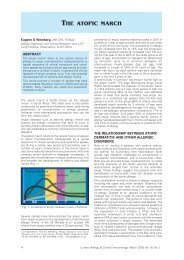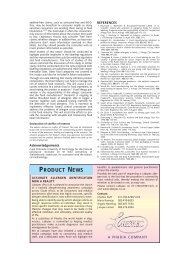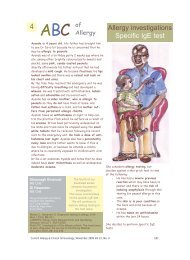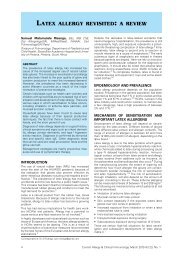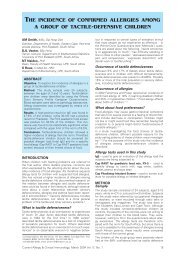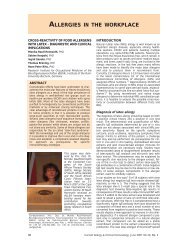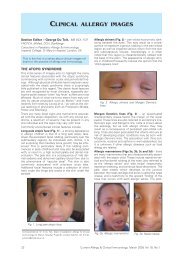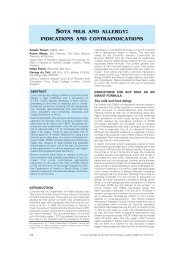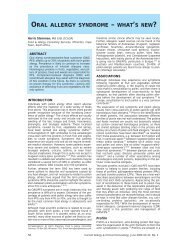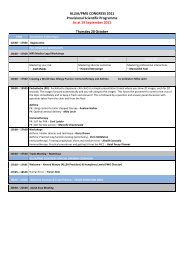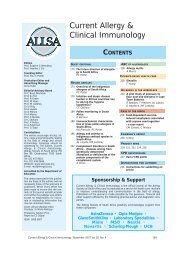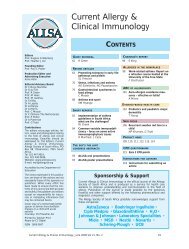Current Allergy and Clinical Immunology - March 2008
Current Allergy and Clinical Immunology - March 2008
Current Allergy and Clinical Immunology - March 2008
You also want an ePaper? Increase the reach of your titles
YUMPU automatically turns print PDFs into web optimized ePapers that Google loves.
are absent. IL-7Rα gene mutationresults in pureT-cell deficiency. B-cell developmentis normal in boththese groups of SCID, despitethe known role of IL-7 in B-cellsurvival <strong>and</strong> differentiation. 3,4Janus-Kinase 3 (JAK-3) is atyrosine kinase which binds tothe γ-chain cytoplasmic regionthereby mediating γ-chain signallingupon cytokine binding.A deficiency of JAK-3 resultsin a SCID phenotype identicalto SCID-X1.3. Defective V(D)J (variable,domain, joining) gene rearrangementof T-cell receptors(TCR) <strong>and</strong> B-cell receptors(BCR). Approximately 30% ofall SCID patients fall into thisgroup. 2 Clonal diversity of T<strong>and</strong> B cells is generated by thesomatic rearrangement of TCR <strong>and</strong> BCR. This is initiatedby two recombination activating gene (RAG-1<strong>and</strong> RAG-2) proteins. Mutations in the genes encodingthese proteins result in faulty development of T<strong>and</strong> B cells, with sparing of NK cells (T – B – NK + ).Artemis is a protein involved in DNA repair after double-str<strong>and</strong>edcuts have been made by RAG-1 <strong>and</strong>RAG-2. A deficiency of this protein also results inimpaired V(D)J arrangement <strong>and</strong> thus a T – B – NK +phenotype. Patients with artemesis deficiency alsoshow increased sensitivity to ionising radiation.4. Defective pre-TCR <strong>and</strong> TCR signalling. This rareform of SCID accounts for only 1-2% of all cases. 2These pure T-cell deficiencies (T – B – NK + ) are a resultof defects in key proteins involved in pre-TCR orTCR signalling such as CD45 phosphatase or a CD3subunit (CD3δ <strong>and</strong> CD3ε).Although we now know that SCID has many underlyinggenetic defects, all forms of SCID manifest with asimilar clinical presentation, typically with severe infectionsearly in life. The average age of presentation is 6months, when maternal antibodies are declining. 3Infections usually involve the respiratory tract or thegut <strong>and</strong> patients often present with persistent diarrhoea<strong>and</strong> failure to thrive. Opportunistic infectionssuch as Pneumocystis jerovici, C<strong>and</strong>ida albicans, <strong>and</strong>cytomegalovirus, as well as infections with adenovirus,respiratory syncytial virus <strong>and</strong> parainfluenza-3 alsooccur. Children who received BCG vaccination at birthare at risk of dissemination. 3,4 Maternal T-cell engraftmentmay occur in as many as 40% of children withSCID. 10 The maternal placenta is an incomplete barrier<strong>and</strong> maternal cells often occur in healthy neonates. Inimmunocompetent newborns these cells are cleared;however, as SCID infants lack T cells, maternal cellsmay persist. <strong>Clinical</strong> findings vary, with up to 60%asymptomatic <strong>and</strong> symptomatic graft-versus-host diseasemost commonly presenting with skin manifestationssuch as chronic eczematous skin rash or generalisedexfoliative erythrodermia. 10Because of the severity of the clinical presentation,SCID should be regarded as a clinical emergency.Diagnosis should be confirmed as early as possible, asearly diagnosis <strong>and</strong> management significantly improvethe outcome.PROSPECTS FOR NEONATAL DIAGNOSISChildren who are diagnosed early <strong>and</strong> receive appropriatemanagement <strong>and</strong> definitive treatment in the formTable II. Suggested screening test methods for SCIDTest method Dried blood spot Anticipated problemsFBC <strong>and</strong> absolute No High false-positives <strong>and</strong>lymphocyte count-negativesLabour intensiveAbsent TREC Yes 1.5% indeterminateresultsMay need repeat testIL-7 immunoassay Yes 2-tier testingpreliminary stagesLow CD3 immunoassay Yes Preliminary stagesMicroarray mutation Yes Many gene mutationsdetectionthus high falsenegativesFBC – full blood count, TREC – T-cell receptor excision circleof a haematopoetic stem-cell transplant (HSCT) have afar better prognosis than those children in whom thediagnosis has been delayed. 11 Prenatal diagnosis isnow available for those parents who have a positivefamily history. However, many children with SCID areborn to parents with no family history of the disease.Children with SCID are healthy at birth <strong>and</strong> have noexternal characteristics of the condition. The infectiouscomplications which bring them to medical care maynot initially be distinguishable from routine childhoodinfections. Thus diagnosis may be delayed.Newborn screening would identify these children early,before infectious complications set in, thus giving thema better outcome after HSCT. In the USA a SCIDNewborn Screening Working Group was convened inMay 2007 with the goal of pursuing integratedapproaches to SCID screening. SCID is thought tomeet many of the accepted criteria for neonatalscreening 12 in that it is fatal in infancy without definitivetreatment, there is a short asymptomatic period afterbirth, effective treatment is available in the form ofHSCT <strong>and</strong> more recently gene therapy, 13,14 early treatmentimproves outcome <strong>and</strong> the cellular <strong>and</strong> humoraldeficiencies may be detectable through screeningtests.A simple <strong>and</strong> effective test still needs to be identified.<strong>Current</strong>ly a number of screening test methods havebeen suggested for SCID (Table II), some of which arebeing implemented in pilot studies. SCID is a rare disease<strong>and</strong> therefore any screening test needs to have ahigh positive predictive value for it to be accepted fornewborn screening. The main problem with currentlyproposed tests is the rate of false-positive or indeterminateresults. 15 All proposed tests are based on thefact that all patients with SCID are unable to make normalnumbers of T cells. However the test must alsotake into account that maternal T-cell engraftment mayoccur <strong>and</strong> patients with a T – B + phenotype may have anormal number of B cells.All children with SCID are lymphopenic at birth, 3,11,12thus routine blood counts with manual differentialscould diagnose nearly all cases of SCID at birth. 6However there is a high number of both false-positives<strong>and</strong> -negatives, as not all children who are lymphopenichave SCID <strong>and</strong> some patients with SCID may have alow-normal absolute lymphocyte count because of thepresence of B cells (IL2RG, JAK3 <strong>and</strong> IL7R genedefects) or maternal lymphocytes. Furthermore thistest is potentially labour-intensive since it does notmake use of the dried blood spots (DBS) collected rou-<strong>Current</strong> <strong>Allergy</strong> & <strong>Clinical</strong> <strong>Immunology</strong>, <strong>March</strong> <strong>2008</strong> Vol 21, No. 1 21



